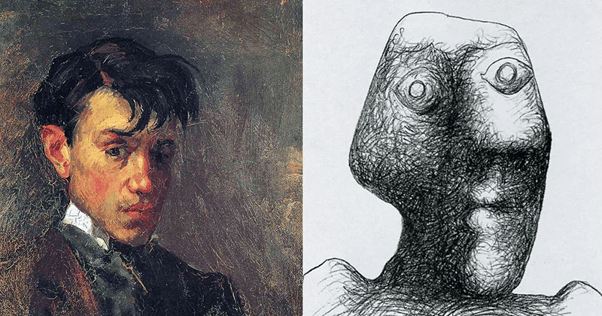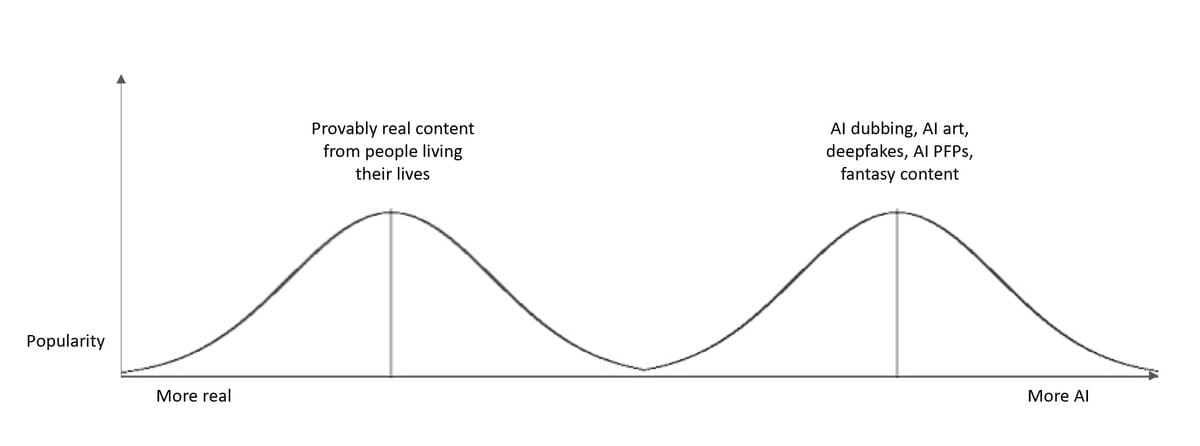Thanks for reading! Quick update before we start: our blog’s URL has changed to consumeourinternet.com. The writing will still be about consumer internet, VC investing and social media, and will arrive in your inbox monthly. We remain hosted on our portfolio company beehiiv, but we wanted to give the newsletter its own domain (and we of course took the opportunity to make another terrible pun / logo combination). Now onto the topic of the day: the AI Barbell in Social Media.

On the left is Picasso’s first ever self-portrait (1896). On the right is his last (1972).
Why did art become more abstract through the 20th century? The simplest explanation: once photography was mainstream, there wasn’t much point painting realistically. Artists needed a new vector to differentiate from the machines, and each other.
We are entering an equivalent paradigm shift in AI, and it’s happening right now. The only thing getting more coverage on my timeline than ChatGPT, Dall-E and Stable Diffusion in recent months has been Prince Harry’s anatomy (among other traumas).
The question: where will content indistinguishable from reality leave self-expression and social media?
We answer with what we call “the AI Barbell”. In this view, some forms of social media will accommodate dramatically more AI, but others will differentiated with less AI, and put an even greater premium on “realness”. The barbell in PPT-generated glory:

Let us explain.
Background: Faster, cheaper…
So far, most AI-social media use cases have been about making content faster, cheaper, and (only sometimes) better.
AI editing tools like Descript, Runway ML, Podcastle, etc. can save hours of wasted content production time and money. So can generative tools which autocreate captions built on GPT-n, and music creation tools (e.g. OpenAI’s Jukebox) can all make generating fresh ancillary content much quicker. Dubbing (notabot), accent adjustment and a series of other services (Ben’s Bites) are all becoming possible at a fraction of the prior cost and effort. Much ink has been spilled to describe them.
Next, we are likely to see entirely new content formats evolve. AI art, deepfakes, fantasy content, new genres of music. As was the case with AI playing chess and Go; the early models played familiar strategies effectively, but later reinforcement learning models developed entirely new strategies. The same can happen for content; it is entirely possible that AI will unlock entirely new vectors for entertainment that we cannot even imagine. Once AI avatars start entertaining us, can you even imagine what hijinks they could entertain us with?
Faster, cheaper… hotter?
So far though, the biggest use case for AI in social has been very simple: making its (paying) users more attractive.
Lensa AI went viral recently augmenting your image in the style of your choosing, with some generous editing, built on top of Stable Diffusion.

At its peak, Lensa made ~$2.5m per day, but this quickly fell to around $200k, still a very impressive number for an app that was unknown just a few months ago.
So, shockingly, there is copious demand for people to make themselves look better. But how will viewers respond? Will they simply accept these AI-generated images and elevate their perception of friends’ attractiveness?
Not so fast, robots
There is nothing more frustrating for a social media user than status-ambiguity.
A recent case of this was when Elon allowed everyone to pay $8 for a blue check. Nobody knew who was important anymore. It drove people crazy. Users want to know if the person on their timeline matters.
Now that AI can easily make people hotter, and it’s pretty much free to post an AI-generated video of yourself prancing, dust-covered, across the Playa at Burning Man, users will want to know if you were really there.
The most important rule from evolutionary psychology is that a signal is only truly meaningful if it is costly. So if anyone can post this content, why would anyone respect it anymore?
This goes deeper than just AI beauty-augmentation. AI-generated voice, video and deepfakes are likely to make people dramatically more sceptical about content they see online (specifically content they do not agree with).
Being… Real?
So once AI-generated content is high-quality and indistinguishable from reality, audiences will want to show what is really real, and creators will want to show it.
Just as artists stopped competing with the camera, it seems likely that we will see new forms of content impossible for AI to mimic. The most likely candidate for this non-AI media will be provably real content. “Raw photos”, AI watermarks (now mandated in China), inhibited snaps. All of these are ways to retain certainty of rawness. I wrote in July about the growth of intimate media, and this will only accelerate that. There is going to be a premium on realness.
So we think the two dominant states of AI in social media will be both (i) more AI and (ii) provably less AI. Hence our barbell:

Tools to enable the next Picasso will become some of the most valuable companies of tomorrow. These will come in two forms: those that heavily leverage AI, and those positioned strongly against it. We will be investing behind both themes.
